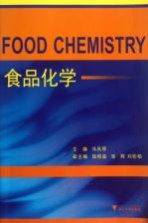

食品化学 英文PDF电子书下载
- 电子书积分:10 积分如何计算积分?
- 作 者:冯凤琴主编
- 出 版 社:杭州:浙江大学出版社
- 出版年份:2013
- ISBN:9787308121224
- 页数:238 页
Chapter 1 Introduction 1
1.1 Definition 1
1.1.1 Food and Food Science 1
1.1.2 Food Chemistry 1
1.1.3 Relationship between Food Chemistry and Other Disciplines 2
1.2 Content and Development of Food Chemistry 2
1.3 Approach to the Study of Food Chemistry 3
1.3.1 Quality and Safety Attributes 3
1.3.2 Chemical and Biochemical Reactions 4
1.3.3 Effect of Reactions on the Quality and Safety of Food 5
1.3.4 Solve Problems by Analyzing and Controlling the Important Variables 6
Glossary 7
Chapter 2 Water 9
2.1 Introduction 9
2.2 Physical Properties and Structure of Water 9
2.2.1 Physical Properties 9
2.2.2 Structure of the Water Molecule 11
2.2.3 Water Intermolecular Interaction 12
2.2.4 Architecture of Water 13
2.3 Quantitative Description of Water in Foods 15
2.3.1 Water Content 16
2.3.2 Water Activity 17
2.3.3 Molecular Mobility 18
2.4 Water Activity and Food Properties 19
2.4.1 Freezing 19
2.4.2 Combined Methods Approach to Food Stability 21
Glossary 23
Chapter 3 Carbohydrate 26
3.1 Introduction 26
3.1.1 Definition 26
3.1.2 Classification 26
3.1.3 Function and Distribution 27
3.2 Physical and Chemical Properties 28
3.2.1 Physical Properties 28
3.2.2 Chemical Properties 30
3.3 Common Sugars 33
3.3.1 Monosaccharides 33
3.3.2 Oligosaccharides 34
3.3.3 Polysaccharide 37
3.3.4 Starch 40
3.3.5 Cellulose 43
3.3.6 Pectin 44
Glossary 45
Chapter 4 Protein 49
4.1 Introduction 49
4.1.1 Definition 49
4.1.2 Classification 50
4.2 Composition 51
4.2.1 Structure 51
4.2.2 Amino Acids 52
4.3 Properties 54
4.3.1 Denaturation 54
4.3.2 Gelation 59
4.3.3 Emulsifying Properties 61
4.3.4 Foaming Properties 64
4.4 Food Proteins 65
4.4.1 Animal Proteins 65
4.4.2 Plant Proteins 71
4.5 Peptides 72
4.5.1 Properties 72
4.5.2 Bioactive Peptides in Food 72
Glossary 73
Chapter 5 Lipids 78
5.1 Introduction 78
5.1.1 Definition and Roles 78
5.1.2 Classification of Lipids 79
5.1.3 Components of Triacyglycerols 79
5.1.4 Edible Oils 81
5.2 Physical Properties 83
5.2.1 Melting Point and Polymorphism 83
5.2.2 Emulsions and Emulsifiers 87
5.3 Chemical Reactivity of Fats and Oils 89
5.3.1 Oxidation 89
5.3.2 Other Reaction 95
5.4 Functional Lipids 98
5.4.1 Functional Fatty Acids 98
5.4.2 Phytosterol 99
5.4.3 Phospholipids 100
5.5 Fat Replacers and Mimetics 100
5.5.1 Fat Substitutes 101
5.5.2 Fat Mimetics 101
Glossary 102
Chapter 6 Vitamins 106
6.1 Introduction 106
6.2 Fat-Soluble Vitamins 107
6.2.1 Vitamin A 107
6.2.2 Vitamin D 109
6.2.3 Vitamin E 110
6.2.4 Vitamin K 111
6.3 Water-Soluble Vitamins 115
6.3.1 Ascorbic Acid 115
6.3.2 Thiamine(Vitamin B1) 119
6.3.3 Riboflavin(Vitamin B2) 122
6.3.4 Nicotinamide(Niacin) 123
6.3.5 Pyridoxine(Pyridoxal,Vitamin B6) 123
6.3.6 Folic Acid 124
6.3.7 Biotin 125
6.3.8 Pantothenic Acid 126
6.3.9 Cyanocobalamin(Vitamin B12) 127
Glossary 128
Chapter 7 Enzymes 130
7.1 Introduction 130
7.2 General Remarks 130
7.2.1 Catalysis 130
7.2.2 Specificity 131
7.2.3 Structures 131
7.2.4 Nomenclature 132
7.2.5 Activity Units 133
7.2.6 Determination of Enzyme Activity 133
7.2.7 Reasons for Catalytic Activity 134
7.2.8 Kinetics of Enzyme-Catalyzed Reactions 135
7.3 Enzymes in Food 141
7.3.1 Amylases 141
7.3.2 Pectic Enzyme 145
7.3.3 Cellulases and Hemicellulases 147
7.3.4 Proteases 147
7.3.5 Lipases 150
7.4 Enzyme Utilization in the Food Industry 151
7.4.1 Starch 151
7.4.2 Baking 151
7.4.3 Brewing 152
7.4.4 Cheese(Flavour) 152
7.4.5 Coffee & Tea 152
7.4.6 Dietetics 153
7.4.7 Egg 153
7.4.8 Juice&Wine 153
Glossary 155
Chapter 8 Colorants 158
8.1 Introduction 158
8.2 Natural Pigments 159
8.2.1 Chlorophyll 159
8.2.2 Heme Compounds 164
8.2.3 Carotenoids 168
8.2.4 Phenolic Compound 172
8.3 Synthetic Colorants 181
Glossary 184
Chapter 9 Flavors 188
9.1 Introduction 188
9.2 Taste and Nonspecific Saporous Sensations 188
9.2.1 Taste Substances:Sweet,Bitter,Sour,and Salty 189
9.2.2 Flavor Enhancers 190
9.2.3 Astringency 191
9.2.4 Pungency 192
9.2.5 Cooling 192
9.3 Vegetable,Fruit,and Spice Flavors 193
9.3.1 Sulfur-Containing Volatiles in Allium sp 193
9.3.2 Sulfur-Containing Volatiles in the Cruciferae 194
9.3.3 Unique Sulfur Compound in Shiitake Mushrooms 196
9.3.4 Methoxy Alkyl Pyrazine Volatiles in Vegetables 196
9.3.5 Enzymically Derived Volatiles from Fatty Acids 197
9.3.6 Volatiles from Branched-Chain Amino Acids 199
9.3.7 Flavors Derived from the Shikimic Acid Pathway 199
9.3.8 Volatile Terpenoids in Flavors 200
9.4 Flavor Volatiles in Muscle Foods and Milk 202
9.4.1 Species-Related Flavors of Meats and Milk from Ruminants 202
9.4.2 Species-Related Flavors of Meats from Nonruminants 204
9.4.3 Volatiles in Fish and Seafood Flavors 205
9.5 Development of Process or Reaction Flavor Volatiles 206
9.5.1 Thermally Induced Process Flavors 207
9.5.2 Volatiles Derived from Oxidative Cleavage of Carotenoids 211
9.6 Future Directions of Flavor Chemistry and Technology 212
Glossary 213
Chapter 10 Food Additive 214
10.1 Introduction 214
10.1.1 Definition 214
10.1.2 Classification 214
10.2 Acids 215
10.3 Bases 217
10.4 Buffer Systems and Salts 218
10.4.1 Buffers and pH Control in Foods 218
10.4.2 Salts in Processed Dairy Foods 219
10.5 Antimicrobial Agents 220
10.5.1 Acid Antimicrobial 220
10.5.2 Ester Antimicrobial 223
10.5.3 Inorganic Antimicrobial 224
10.5.4 Biological Antimicrobial 225
10.6 Sweeteners 226
10.6.1 Saccharin 226
10.6.2 Aspartame 226
10.6.3 Acesulfame K 228
10.6.4 Cyclamate 228
10.7 Emulsifier 229
10.7.1 Emulsifier Action 230
10.7.2 Synthetic Emulsifiers 233
10.8 Antioxidants 235
Glossary 235
References 237
- 《分析化学》陈怀侠主编 2019
- 《化学反应工程》许志美主编 2019
- 《危险化学品经营单位主要负责人和安全生产管理人员安全培训教材》李隆庭,徐一星主编 2012
- 《奶制品化学及生物化学》(爱尔兰)福克斯(FoxP.F.)等 2019
- 《有机化学实验》雷文 2015
- 《全国普通高等中医药院校药学类专业十三五规划教材 第二轮规划教材 分析化学实验 第2版》池玉梅 2018
- 《生物化学》田余祥主编 2020
- 《长江口物理、化学与生态环境调查图集》于非 2019
- 《化学工程与工艺专业实验指导》郭跃萍主编 2019
- 《天然药物化学》孔令义主编 2019
- 《大学计算机实验指导及习题解答》曹成志,宋长龙 2019
- 《浙江海岛植物原色图谱》蒋明,柯世省主编 2019
- 《大学生心理健康与人生发展》王琳责任编辑;(中国)肖宇 2019
- 《大学英语四级考试全真试题 标准模拟 四级》汪开虎主编 2012
- 《大学英语教学的跨文化交际视角研究与创新发展》许丽云,刘枫,尚利明著 2020
- 《复旦大学新闻学院教授学术丛书 新闻实务随想录》刘海贵 2019
- 《大学英语综合教程 1》王佃春,骆敏主编 2015
- 《美丽浙江 2016 法语》浙江省人民政府新闻办公室编 2016
- 《二十五史中的浙江人 24》浙江省地方志编纂委员会编 2005
- 《大学物理简明教程 下 第2版》施卫主编 2020
